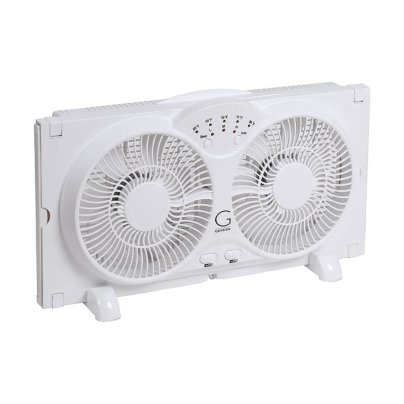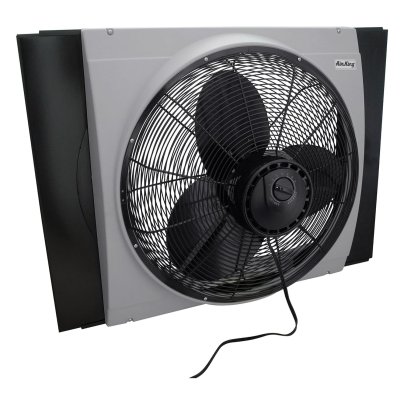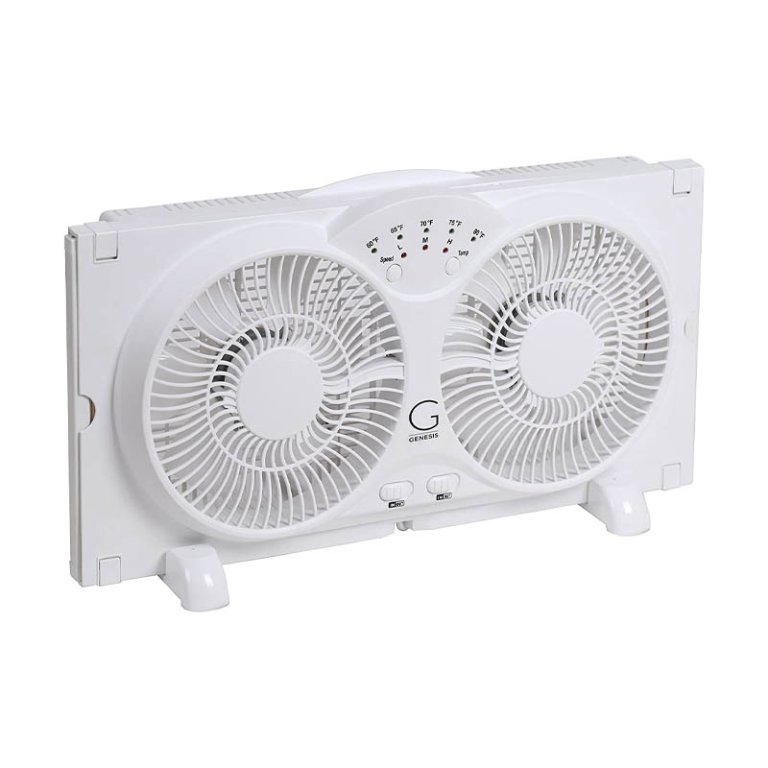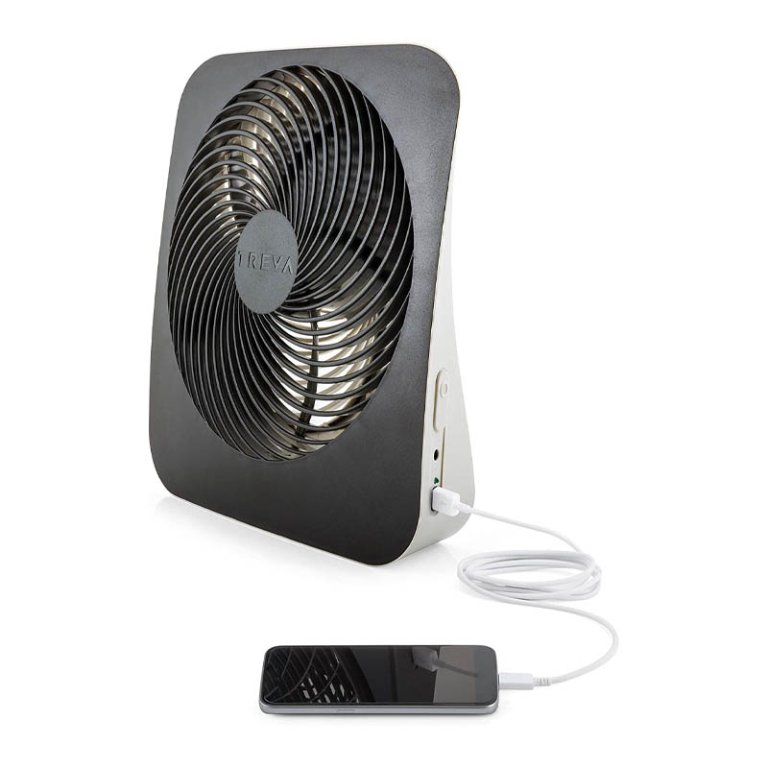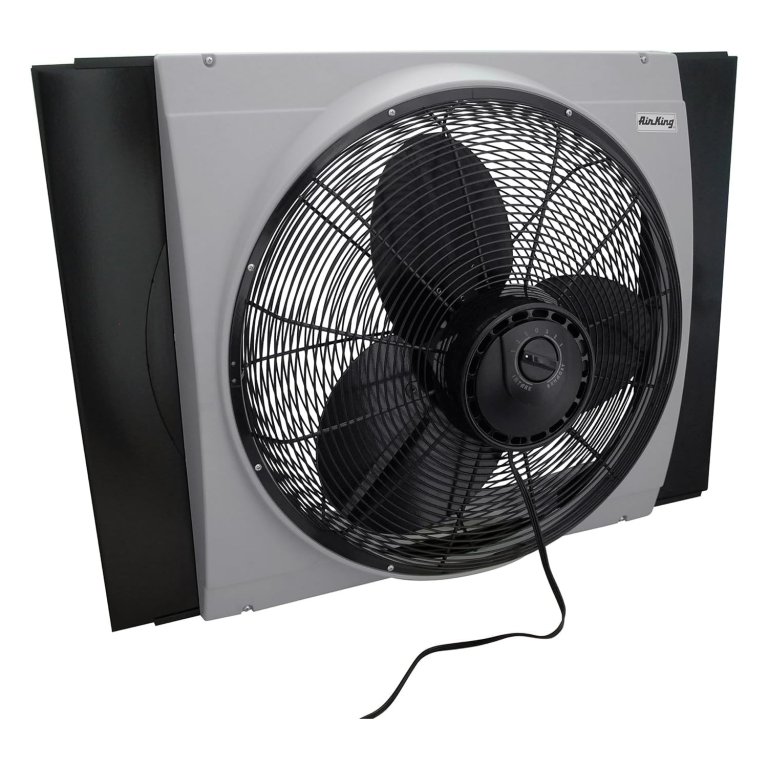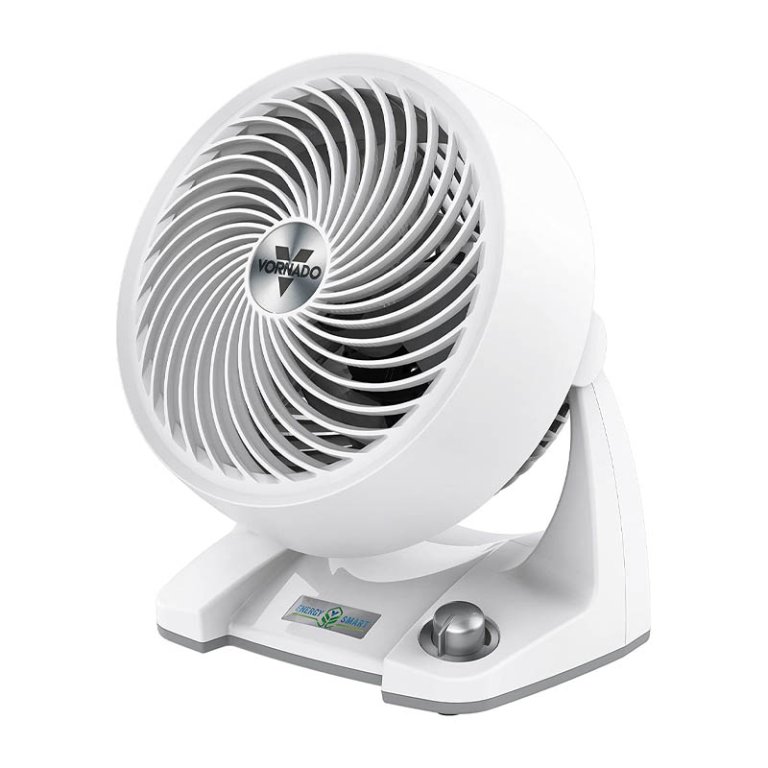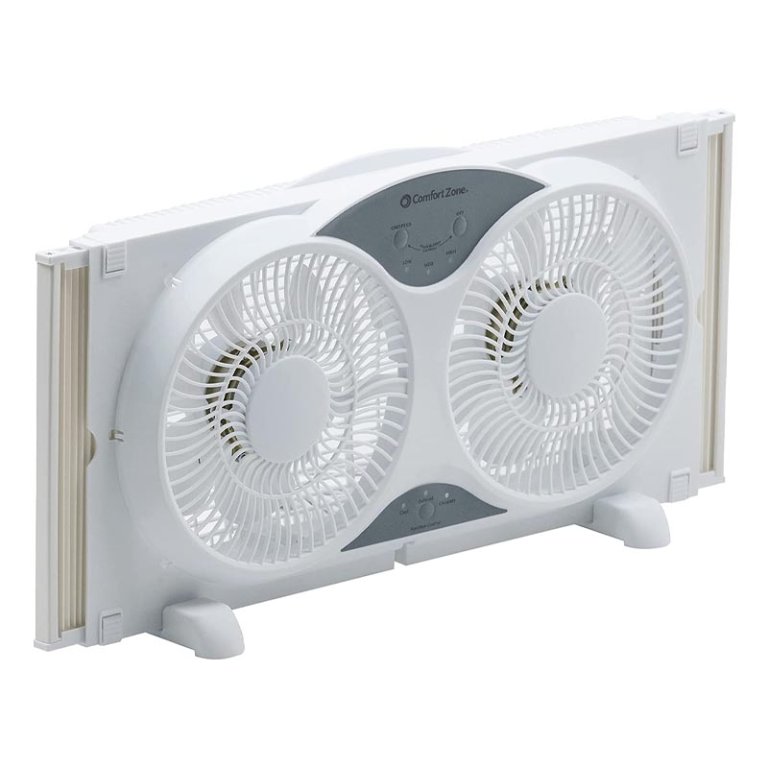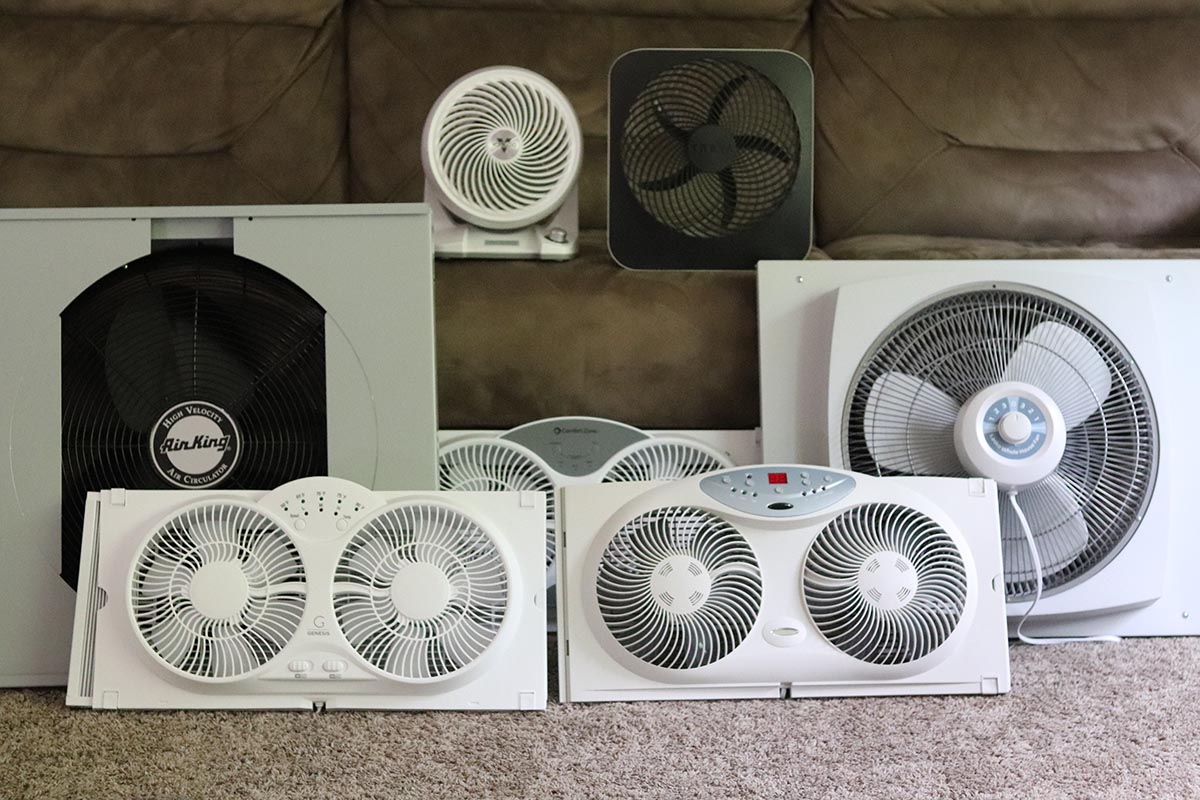
We may earn revenue from the products available on this page and participate in affiliate programs. Learn More ›
When it comes to keeping your home cool and slashing your electric bills, you can’t beat a window fan. These devices mount to the bottom of a typical window frame and circulate air to bring in a breeze, consuming much less energy than an air conditioner. We tested the fans that made our list, evaluating their ease of installation, airflow, and noise level, among other factors.
Our top pick is the Genesis A1 Window Fan. Thanks to its accordion panels, it snugly fits into most window openings but can also be used as a free-standing fan via the included feet. We also like the adjustable thermostat and the reversible airflow of the dual fans.
While hardly high-tech tools, the best cooling fans have a few features that suit them to specific functions, so it pays to be a discerning shopper. Read on to learn what you should look for in the best window fans, and how these criteria and our hands-on testing informed our top picks.
- BEST OVERALL: Genesis A1 Window Fan
↓ Jump to Review - BEST BANG FOR THE BUCK: O2Cool Treva 10-Inch Portable Battery Powered Fan
↓ Jump to Review - BEST WHOLE HOUSE: Air King 20-Inch Whole House Window Fan
↓ Jump to Review - BEST COMPACT: Vornado Energy Smart Small Air Circulator Fan
↓ Jump to Review - EASIEST TO USE: Comfort Zone 9-Inch Reversible Twin Window Fan
↓ Jump to Review

Window Fan Comparison
| Product | Airflow | Size | Reversible |
|---|---|---|---|
| Genesis A1 Window Fan | 2,500 cfm | 12 inches long by 24 inches wide by 4 inches deep | Yes |
| O2Cool Treva 10-Inch Portable Battery Powered Fan | N/A | 13.19 inches long by 12.08 inches wide by 4.02 inches deep | No |
| Air King 20-Inch Whole House Window Fan | 3,560 cfm | 26.75 inches long by 11.25 inches wide by 26.25 to 37.5 inches deep | Yes |
| Vornado Energy Smart Small Air Circulator Fan | 358 cfm | 11.3 inches long by 9.65 inches wide by 7 inches deep | No |
| Comfort Zone 9-Inch Reversible Twin Window Fan | 431 cfm | 13.75 inches long by 23.5 to 37 inches wide by 4.75 inches deep | Yes |
Our Top Picks
The list of top window fans below, which we researched and tested, includes floor and desk fans as well as standard frame window fans. These fans are powerful enough to create air circulation that can cool a room and feature controls that make them easy to operate.
Best Overall
Genesis A1 Window Fan
Buy at Amazon Buy at The Home Depot Buy at WalmartWhat We Like
- Thermostat or standard controls to suit users’ preferences
- Can function as a stand-alone or window fan
- Provides ample airflow
What We Don’t Like
- Materials feel cheap compared to similar window fans available
Product Specs
- Airflow: 2,500 cfm
- Size: 12 inches long by 24 inches wide by 4 inches deep
- Reversible: Yes
Our Ratings: Installation 4/5; Air Circulation 4.5/5; Noise 3.5/5; Cleanability 5/5; Value 4.3/5
Loaded with features that make it easier to control, coupled with a design that allows one to either install it into a window or use it as a freestanding fan, this dual window fan is one of the more versatile options on the market. Accordion panels on the sides help create a good fit. However, users should expect some wrestling as they try to expand the stiff panels while locking them in place from the top and bottom.
It also comes with feet, which can be attached to turn the fan into a freestanding model. The feet were easy to put on and take off during testing. There are three speed settings, and users can toggle the direction of each fan independently to intake or exhaust. This was the only fan we tested that allowed us to change the direction of each fan independently. It was a nice feature, though it probably would’ve worked better if we could have gotten a better seal with the window.
Users can choose to set each fan to a specific speed or automate the fans by using the thermostat temperature settings on the Genesis, which is a handy feature. One thing we didn’t like, however, was how cheap the materials felt. It seemed like if we dropped this fan, it would most definitely break.
What our tester says: “I liked leaving this fan on the automatic setting so I could set it and forget it. It provided good airflow and wasn’t too noisy unless it was on the highest setting.”–Stacey L. Nash, Product Reviews tester and writer
Get the Genesis window fan on Amazon, The Home Depot, Walmart, or at Genesis.
Best Bang for the Buck
O2Cool Treva 10-Inch Portable Battery Powered Fan
Buy at Amazon Buy at WalmartWhat We Like
- Compact fan suitable for desks or windows
- Runs off batteries or AC power
- Quiet operation, even on highest setting
- Freestanding design can be moved where needed
What We Don’t Like
- No reversible airflow
- Less powerful than standard window fans
Product Specs
- Airflow: N/A
- Size: 13.19 inches long by 12.08 inches wide by 4.02 inches deep
- Reversible: No
Our Ratings: Installation 5/5; Air Circulation 3/5; Noise 4.5/5; Cleanability 5/5; Value 3.5/5
Though this desk fan may not be a traditional window fan, its slim design and square shape make it a great option for those looking for relief from the summer heat on a budget. Its 10-inch blade isn’t quite as powerful as higher-priced small window fans. However, during testing, we found that it could move enough air to provide cooling relief on a hot day in a small room or within 10 feet when outside. It also offers the advantage of versatile power options, operating off AC power or six D batteries.
However, batteries aren’t exactly cheap these days, and relying on the battery too much could get pricey. We ran this fan for 4 days straight on the six D batteries, which is a pretty good life. Batteries also make it super quiet.
Since it isn’t tethered to a power cord, the O2Cool is suitable for camping as well as home use. This narrow window fan measures 12 inches wide, 13 inches high, 4 inches deep and weighs just over 2 pounds and is ideal for moving from room to room or even taking on the road. We moved it around the house from an office to the bathroom to outside and back to the office, which became its home. It also has a convenient port for charging a smartphone. We tested the charger, and it wasn’t fast, but it’s handy in a pinch.
Get the O2Cool window fan on Amazon or Walmart.
Best Whole House
Air King 20-Inch Whole House Window Fan
Buy at Amazon Buy at WalmartWhat We Like
- Powerful window fan; suitable for large living spaces
- Durable metal construction will last for years
- Fits standard window sizes
- Comes with multiple useful speed settings
What We Don’t Like
- No remote control included with purchase; must be adjusted manually
- Large size won’t suit very small windows
Product Specs
- Airflow: 3,560 cfm
- Size: 26.75 inches long by 11.25 inches wide by 26.25 to 37.5 inches deep
- Reversible: Yes
Our Ratings: Installation 3/5; Air Circulation 5/5; Noise 2.5/5; Cleanability 5/5; Value 5/5
When your entire home feels like a sauna, flood it with cool air from floor to ceiling with this powerful fan. The Air King fits windows between 27 and 38 inches wide and at low-, medium-, or high-speed settings, it delivers an airflow of 2,510, 3,120, or 3,560 cfm. On its highest setting, the Air King can cool up to 1,310 square feet.
We can attest to the power of this high cfm window fan. During testing, there was an unfortunate accident on the stove that left behind some seriously unpleasant odors. We turned this fan on exhaust, and the house was cleared of odors within 10 minutes. It’s heavy and loud but powerful.
There’s no remote control with this model, but it’s reversible. We didn’t love the installation process. It comes with a guide and sliding panels to fit it to the window, and it must be screwed into place. Two people are needed to install this behemoth.
What our tester says: “I tested this fan in my 2,318-square-foot home, and could feel cool air moving in almost every room, going beyond the advertised 1,310 square feet.”–Stacey L. Nash, Product Reviews tester and writer
Get the Air King window fan on Amazon or Walmart.
Best Compact
Vornado Energy Smart Small Air Circulator Fan
Buy at Amazon Buy at Walmart Buy at VornadoWhat We Like
- Easy to move compact and lightweight construction
- Ample airflow for its size
- Variable airflow adjustment
What We Don’t Like
- Loud on the highest speed; may not be ideal for use on a desk
Product Specs
- Airflow: 358 cfm
- Size: 11.3 inches long by 9.65 inches wide by 7 inches deep
- Reversible: No
Our Ratings: Installation 5/5; Air Circulation 5/5; Noise 3.5/5; Cleanability 5/5; Value 5/5
With its compact size, this powerful Vornado window fan is a nice alternative to a traditional window fan. It measures just 11 inches high and just under 10 inches wide but packs a punch thanks to its design. Its spiral-shaped grate and powerful brushless motor allow it to move air up to 75 feet.
This little fan became a favorite during testing. It has a variable speed dial that adjusts the airflow. It can go from whisper quiet to a wind-blowing tornado and everything in between. A powerful motor creates far more airflow than one might expect from its size. The Vornado can also tilt upward or downward, making it easy to direct airflow. Plus, it’s small and lightweight (only 3.5 pounds), so it can be carried from room to room.
Get the Vornado window fan on Amazon, Walmart, or Vornado.
Easiest to Use
Comfort Zone 9-Inch 3-Speed Reversible Twin Window Fan
Buy at AmazonWhat We Like
- Functions as stand-alone or installed window fan
- Settings can be adjusted via the remote control
- Easy to install
- Reversible window fan with multiple settings
What We Don’t Like
- Not as powerful as other window fans available
- Remote control didn’t work as well as expected
Product Specs
- Airflow: 431 cfm
- Size: 13.75 inches long by 23.5 to 37 inches wide by 4.75 inches deep
- Reversible: Yes
Our Ratings: Installation 5/5; Air Circulation 4/5; Noise 3.5/5; Cleanability 5/5; Value 2.7/5
With its simple controls, this twin window fan from Comfort Zone is one of the easiest to operate. The fan’s control panel, which sits conveniently between the two fans at the top and bottom of the unit, consists of an off button and an on button that also sets the fan to one of three speed settings. We also appreciated that this fan came with bug screens. None of the other window fans with a similar design did.
Controls at the bottom of the fan make it easy to set the fans to exhaust, intake, or circulate, which runs the two fans in opposite directions. Thanks to its reversibility, it could even be used as a bathroom window exhaust fan in a pinch. With detachable feet and lockable accordion panels that extend from the side, this fan can be set up as either a stand-alone fan that rests on a windowsill or a fan that fits tightly between the sash and jamb of windows between 23.5 inches and 37 inches wide. We installed the Comfort Zone in under 5 minutes. We found the accordion panels were easier to adjust than on some of the other models we tried.
However, while the manufacturer reports this fan at 431 cfm, it didn’t feel nearly as powerful as most of the other fans we tested. And it came with a remote, but it didn’t work. Honestly, it doesn’t really need a remote. It would be nice, but the controls are so simple to operate that no remote is necessary.
Get the Comfort Zone window fan at Amazon.
Jump to Our Top Picks
How We Tested the Best Window Fans
| Products tested | 7 |
| Time spent testing | 14+ hours |
| Tests performed | 6 |
| Price range | $30 to $250 |
We tested and scored each fan according to an established rubric. Two fans that we originally tested and recommended, the Lasko 16-Inch Window Fan with E-Z-Dial Ventilation and the Bionaire Window Fan with Twin Reversible Blades, have since gone out of stock, so we’ve pulled them from this list.
In testing, we considered the quality of the materials, noise, airflow/cooling ability, and extra features. We also had to consider installation ease, since most of these fans had to be installed in a window frame. Each fan was run for at least 2 hours, though usually longer, and all settings were tested.
- Materials: It came down to plastic or metal blades and grills with these fans. Metal always offers better durability, but it comes at a higher price and poor energy efficiency.
- Noise levels: We tested noise levels by carrying on conversations and watching television while the fans ran to see how disruptive they were.
- Airflow/cooling: The cfm rating can be deceptive when it comes to actual airflow. The fans’ design and motor affected how cooling they felt versus what the specs said they could do. We tested all airflow settings.
- Extra features: We evaluated extra features like a remote control, built-in thermostat, extension panels, and feet. We also scored how well they benefited the fans’ usability.
| Product | Installation | Air Circulation | Noise | Cleanability | Value |
| Genesis A1 Window Fan | 4/5 | 4.5/5 | 3.5/5 | 5/5 | 4.3/5 |
| O2Cool Treva 10-Inch Portable Battery Powered Fan | 5/5 | 3/5 | 4.5/5 | 5/5 | 3.5/5 |
| Air King 20-Inch Whole House Window Fan | 3/5 | 5/5 | 2.5/5 | 5/5 | 5/5 |
| Vornado Energy Smart Small Air Circulator Fan | 5/5 | 5/5 | 3.5/5 | 5/5 | 5/5 |
| Comfort Zone 9-Inch Reversible Twin Window Fan | 5/5 | 4/5 | 3.5/5 | 5/5 | 2.7/5 |
What to Consider When Choosing the Best Window Fan
Consider these features when navigating the wide and varied array of window-fan options available today. Certain fan features will be more suitable for your space and are important to know about when shopping to get the best cooling performance.
Type
When shopping for the best cooling fan, it’s important to consider which of the three types of fans is best suited for the job. Window fans come in three different types: standard frame, desk, and floor.
- Standard frame: This type of window fan is designed to sit inside the window between the sash and the sill. Unlike a box fan, which simply sits on the sill, a window fan is installed using mounting hardware and has adjustable panels that fill the gaps on either side of the fan. These fans may also be held in place with a sliding window. Some standard frame fans are vertical window fans that can have either single or double blades. Unlike other fan types, a standard-frame fan is often reversible, allowing it to function as either an intake or exhaust fan, or both simultaneously. Since a standard frame is positioned inside the window, it does the best job of moving air in or out of a room.
- Desk: A desk fan is smaller than a window fan but has a base that allows it to stand upright on a flat surface, such as a desk, near a window without the need for installation. Unlike standard frame fans, which have a fixed position, desk fans have a tilt feature that allows the user to aim them up or down.
- Floor: Floor fans, like desk fans, are mounted to a base. They sit taller than desk fans and typically have larger blades, so they are capable of moving more air through screen doors and low windows. Like desk fans, they typically have adjusters that allow the user to tilt them up or down.

Size/Dimensions
Since a window fan is intended to fit inside a window, it should not be larger than the window’s dimensions. For this reason, most standard window fans can fit windows about 26 inches to 38 inches wide.
When shopping for a window fan, make sure to choose a model that is just small enough to fit the dimensions of the window when open, which ensures that there aren’t large gaps around it that can allow warm air to enter the room or grant access to bugs should the window not have a screen. Many window fans have sliding guards on the sides that cover these gaps to prevent drafts from around the fan while also keeping bugs and rain out. If you’d like to position a fan into a slider window, be sure to purchase a vertical window fan, as most fans are made to fit standard single- or double-hung windows.
Material
Window fans consist of a housing that holds one or two blades, which are protected by a grate. These parts typically consist of either high-quality plastic or metal.
- Blades: Window fans have either plastic or metal blades. Fans that have plastic blades are lighter and therefore more energy efficient than metal fans. However, since the plastic parts aren’t as strong as metal, they don’t produce as much airflow. Metal fans, though heavier, can endure greater stress and therefore can be equipped with bigger motors that produce more revolutions per minute (rpm). As a result, metal fans can produce an airflow of 3,500 cubic feet per minute (cfm) or more compared to plastic fans, which are limited to around 2,500 cfm.
- Grates: All fans have either a metal or plastic grate that prevents objects or hands from coming into contact with the blades. While metal grates are more durable than plastic and can endure more abuse, they are also susceptible to rust and corrosion.
- Housing: Most window fans have a housing made of a durable grade of plastic. Though not as strong as metal, the plastic housing helps to keep the fan’s overall weight down. Plastic is also impervious to rust and corrosion that can eventually ruin metal fans.
Airflow
The airflow of a fan, an indicator of its cooling power, measures the velocity at which air enters or escapes a space. Airflow will be indicated on the fan manufacturer’s website and on the fan packaging in cfm.
While it may seem advantageous to buy a fan with the highest cfm available, a unit with a stronger airflow than the room warrants can just waste energy. It’s more prudent to buy a fan with an airflow sufficient to cool the space where it will be installed. In general, figure about 1 cfm per square foot of space, plus an extra 50 cfm.
Most window fans have both an intake function (to draw in and circulate air from the outdoors) and an exhaust function (to force out indoor air or odors). Reversibility refers to the mechanism that changes airflow direction. There are manually reversible and electrically reversible fans.
Manually reversible fans require the user to physically remove the unit from the window, flip it, and reinstall it to reverse airflow. Electrically reversible fans allow the user to change airflow direction with the push of a button or the flip of a switch, a major convenience with intake and exhaust functions at various times on any given day. For example, the intake function is useful while sleeping to draw in cool nighttime air, while using the exhaust function by day expels hotter air.
Number of Internal Fans
- One-fan units house one large centralized internal fan that enables air circulation. Because one-fan units bill themselves as “whole-house” fans to cool the entire home, they tend to deliver a stronger airflow (more on that below). That said, their large single fan makes them bulkier and less efficient on the whole, thus it’s slower to cool an individual room.
- Two-fan (or “twin”) units feature two small side-by-side internal fans. They’re more compact, and while they offer a slightly lower airflow on average, two fans work more efficiently to cool a room faster. Bonus: In a two-fan unit with electrical reversibility and independent control of the fans via two intake/exhaust switches, one fan can perform intake while the other set performs exhaust, thereby maximizing cooling efficiency and indoor comfort.
Noise Level
Most window fans generate between 40 and 80 decibels (dB), depending on how close one is to the fan. Standard window fans produce similar noise levels to floor fans, while desk fans with smaller blades are quieter, operating at less than 40 dB. If a fan is too noisy, the user can make it quieter simply by running the fan on a medium- or low-speed setting. Keep in mind that many manufacturers won’t list the fan’s decibels, so read reviews if you’re in search of a quiet window fan.
Additional Features
Many window fans come with some convenient extras, and certain models tend to look better in specific spaces.
- Control panel: Window fans generally have a control panel on the front to turn the unit on and off, switch between intake/exhaust modes, adjust airspeed and temperature, and tilt or angle the blades. Some models include a digital thermostat as well.
- Remote control: Some models come with a remote control for common functions, so there’s no need to get up to operate it manually. This is a great bonus for those with limited mobility, if the fan sits in an overly large room, or if most of the seating is positioned far from the window.
- Portability: Window fans designed to be portable usually have a lightweight build and may come with a handle and collapsible legs. Some are battery-powered for even more flexible usage.
- Aesthetic: Window fans range from neutral white and black to sleek metallic finishes that ideally blend in with the surrounding frame. Fans with a shallow profile help achieve this unobtrusive look.
Installation and Maintenance
Most window fans are easy to install and maintain. Desk fans and tower fans can stand on their own, eliminating the need for an installation that requires drilling holes and driving in screws.
Most window fans fit between the sash and sill of the window and must be fastened to the window frame with screws to hold it firmly in place while it operates. Models that come with guides can help make sure that the screws are installed correctly. Other fans are designed so that the window sits on top of the unit, holding it in place. Most window fans have panels that extend from the sides to close off the gaps in the window opening on either side of the fan.
FAQs
Attic fans, per their name, are installed in the attic through the ceiling or an exterior wall of the home. The fans work by removing hot air from the attic while sucking in cooler air through the home’s soffits. A window fan fits into the window of a home, removing hot air or circulating cooler air to reduce the room temperature.
Window fans can help reduce the temperature in a room by removing hot air from a room or circulating in cooler air.
Since a window fan’s job is to suck air into a room, it can bring bugs with it. With that in mind, make sure the window fan either has a built-in bug screen or will fit into the window while allowing the window screen to remain in place.
While a fan with more cubic feet per minute is desirable, for a window fan to be effective, it should move one cfm for every square foot of space, plus an extra 50 cfm. So, for a window fan to effectively cool a 200-square-foot room, it should have at least 250 cfm.
If possible, use two fans, one set to exhaust to push warm air out of the room and one set on intake to pull cool air into the room. You can also place a powerful fan on one end of the house set to exhaust and open one window at the opposite end of the house. The fan will pull hot air out and cool air in.
To clean a fan, start by unplugging the fan and removing the protective grate if possible. (Check the manufacturer’s instructions because not all grates are removable.) Use a vacuum hose with a dusting brush to clean off the fan blades, then wipe them down with a damp cloth and reattach the grate.
Window fans can make a room feel cooler without using much electricity, making them worthwhile if you’re looking for a low-cost alternative to running air conditioning.
The best place for a window fan depends on whether you need to exhaust hot air from your home or bring cool air in. To draw in cool air, place the fan in a window on the coolest side of your house and face it inward. To expel warm air, position the fan facing outward in the hottest area of your home.
Most window fans use between 50 and 100 watts of electricity, which is a fraction of what a small air conditioner consumes.
